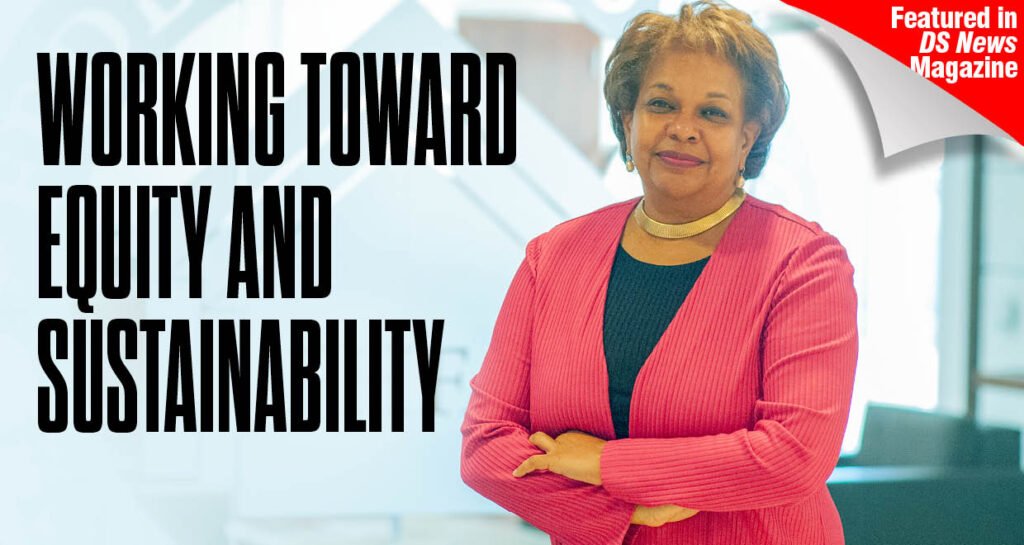
President Biden appointed Sandra L. Thompson as Acting Director of the Federal Housing Finance Agency (FHFA) on June 23, 2021, capping a long career within government that included serving as Deputy Director of the Division of Housing Mission and Goals (DHMG) since March 2013.
In that role, Thompson oversaw FHFA’s housing and regulatory policy, capital policy, financial market activities, fair lending, and the community and economic development mission for Fannie Mae, Freddie Mac (together, the Enterprises), and the Federal Home Loan Banks.
Prior to joining FHFA, Thompson worked at the Federal Deposit Insurance Corporation (FDIC) for more than 23 years, serving in various roles such as Director of the Division of Risk Management Supervision. At FDIC, she led the Agency’s examination and enforcement program for risk management and consumer protection at the height of the financial crisis. She also led the FDIC’s outreach initiatives in response to a crisis of consumer confidence in the banking system.
On March 16, the Senate Banking Committee advanced Thompson’s nomination as Director of FHFA. Just a few weeks prior to that, Thompson spoke with DS News to discuss her priorities and goals within FHFA, as well as the challenges she is working to surmount, including a commitment to the guiding principles of accessibility, affordability, sustainability, transparency, and accountability.
What are the key accomplishments you’d like to highlight since you took on the role of FHFA’s Acting Director last summer?
The first thing I’d like to acknowledge is the support of the FHFA staff, work can be very challenging during a transition. This staff has really stepped up and provided support in every single way possible, we didn’t miss a beat.
One of the first things we did was remove the Adverse Market Refinance Fee [Which was announced on July 16, 2021–Ed.]. This fee was put in place to cover pandemic-related losses. At the time the fee was announced, losses to the Enterprises were unknown. The good thing is that the Enterprises didn’t have to absorb the anticipated losses. Enterprise loans performed well, both single- and multi-family.
When we eliminated the fee, borrowers were better able to take advantage of the low interest rate environment. That was one of the first actions that we took, and it was a win-win: a win for the Enterprises and a win for borrowers because sellers were able to pass through the savings to borrowers.
The other thing we’ve been proud of is our request for the Enterprises to submit Equitable Housing Finance plans. The purpose of these plans is to identify and address barriers to fair and sustainable housing opportunities. We asked the Enterprises to focus on providing liquidity in additional areas that are hard to serve. As you all know, it’s easy to do the daily bread-and-butter loans. But we want to focus the Enterprises on providing liquidity in areas that are harder to serve, especially targeting low- to moderate-income communities, underserved communities, and particularly communities of color. We already have the Duty to Serve plans that focus on rural areas, affordable housing preservation, and manufactured housing. And we have the Enterprise Affordable Housing Goals that focus the Enterprises on low- to moderate-income purchases and refinances, as well as low-income areas. But the Equitable Plans were something new, and we were excited about having the opportunity to have the Enterprises look at these issues, take advantage of some of the lessons that have been learned from the last financial crisis, and apply that information toward trying to provide liquidity in additional areas that are hard to serve.
The Equitable Housing Plans are going to detail how the Enterprises can promote equity within housing finance, specifically focusing on closing the racial homeownership gap and supporting formerly redlined communities. A house is probably the single largest asset that many people own, and there’s a huge equity gap we believe can be closed through homeownership. We’re hoping that the Equitable Housing Plans will be helpful in that respect.
One other thing I’d like to highlight is the announcement that Fannie Mae is considering including rental payment history in their risk assessment underwriting processes. With this update, borrowers are going to have the benefit of positive rental payment history being included in underwriting decisions. It’s groundbreaking because, as you know, in many households rent is the single largest monthly expense. There isn’t any reason for someone who’s making timely rent payments to not have those included in the underwriting calculations. Certainly, I think the way we are assessing the ability to repay and the willingness to repay ought to be taken into consideration. I do want to make clear that rental payment consideration is not going to be the only factor, it’s going to be an additional factor.
What are your top priorities for FHFA over the next few years? What sort of legacy do you hope to leave behind once you eventually depart FHFA?
That’s a great question. We just released a draft Strategic Plan for public input in February, and the high-level priorities are outlined there. Those three priorities include securing the safety and soundness of our regulated entities, fostering a sustainable and equitable housing finance system, and serving as responsible stewards of our Agency. Internally at FHFA, we want to make sure that we have a culture of dignity, inclusion, and respectful accountability.
Let me start with item number one, securing the safety and soundness of our regulated entities. I worked at the FDIC for about 23 years, and in my last seven years there, I served as the head of risk management supervision. So, safety and soundness are important to me. What I want to do is make sure that the public at large has confidence in Fannie Mae, Freddie Mac, and us as their regulator. They certainly are not the Enterprises that existed in 2008, when they were placed into conservatorship. There were lots of questions about housing finance at the time, and about the mortgage market, specifically. We had loan products that were predatory. There were loans the borrowers didn’t understand and couldn’t afford. Borrowers’ ability to repay was questionable throughout the Great Recession, with all the associated delinquencies and foreclosures. As such, confidence in the mortgage market and the mortgage system is important now more than ever. And I do believe that if we have a sound regulatory structure in place and we’re executing against that as regulator, that goes a long way towards building public confidence, and that’s important to me.
I want the Enterprises to be as financially strong as they possible. I would love to see them continuing to retain earnings and build capital and be in a strong position by the time that my tenure as Acting Director or Director (if confirmed) ends. We’re working towards that goal every day.
Ensuring a sustainable and equitable housing finance system is also important. We’ve had conversations for years about underserved areas, and, in particular, rural areas. There are many challenges, ranging from appraisals and valuations to making sure that certain areas have liquidity and that borrowers can have a level playing field and broad access to the programs that Fannie Mae, Freddie Mac, and the Federal Home Loan Banks offer. We need to make sure we are making adjustments because one size does not fit all.
It is important to note that equity is different from equality. When you are equal, everybody gets the same thing. But when you have equity, solutions can be tailored for the particular problem that needs to be addressed. Equitable housing is important to me; sustainability is important to me.
After going through the 2008 crisis—and even the savings and loan crisis before that—I believe affordability and sustainability are one and same. You certainly want to make sure that borrowers can afford to repay their loans, that they understand those loans, and that those loans will be sustainable over the long haul.
What would you say the industry should be doing to help raise homeowner awareness of the options they may have as they’re coming out of forbearance plans as they trying to get back current with their mortgage payments?
The industry must continue to use the multiple communication tools that they have to make sure that broader populations understand the options available. One of the things we learned from the last crisis was that you have to have different communication tools, and they have to reach different kinds of audiences. And one of the things that we would recommend for this cycle is to make sure that servicers and borrowers are working with housing counseling organizations and with each other to bring attention to some of the different options that are available. Public awareness of available options is very important, especially when a borrower is coming out of forbearance.
For us, the impact to the more than 2 million borrowers who received forbearance, while significant, hasn’t resulted in the delinquencies that we saw during the Great Recession. We have seen some very promising outcomes because we got together with Fannie and Freddie and directed them to put in place a new home retention option called a Payment Deferral. When we look at the outcomes, about 30% of loans that were in forbearance have utilized the payment deferral or modification option. We have seen recently an increase in some of the trial modifications, but 30% have also had refinances or sales. About a third of those participated in loss mitigation post-forbearance, but about 20% cured right after their forbearance period ended. Many of them even paid while they were on forbearance. We were pleasantly surprised at that.
It goes back to the first topic I mentioned, the Adverse Market Fee. We were expecting significant losses. It’s a real testament to the work that Fannie and Freddie and the industry did to put together loss mitigation options that work, and specifically, the payment deferrals and the other modifications that were utilized throughout the pandemic.
Having an ultimate solution that results in increased home retention is important. Foreclosure is expensive, it’s a very lengthy process, and it’s disruptive. We understand that sometimes people get in trouble, so we focus on home retention options. We want to make sure that servicers and the Enterprises are looking at solutions that keep borrowers in their home and able to pay their mortgages.
Do you anticipate that any of these programs and changes that were implemented due to the pandemic may become permanent?
We’ve been working for years on developing effective loss mitigation programs for use in a crisis. Certainly, we work with HUD and Treasury to maintain some very strong loss mitigation programs. We’re going to examine how these programs have performed, and identify the lessons learned from the programs, as we’ve done on the origination side. Like accessibility: it is key to ensure that there’s a simple process in place for homeowners to seek mortgage assistance. We want to make sure that as many homeowners as possible can easily obtain the needed and appropriate level of assistance. It also has to be affordable. We also want to make sure that homeowners have meaningful payment relief that addresses their specific needs.
A second important lesson is that homeowners need to work with their servicer to make sure that the modification results in a significant payment reduction. We have found that payment relief or payment reductions were what works best.
The third thing that I’ll talk about is sustainability. We need to make sure that the solutions are designed so they can work in the long term, so they’re not just a stopgap measure that works for a few months, or that we are just kicking the can down the road. There are a number of stakeholders involved and making sure that these solutions provide meaningful impact for the borrower, servicer, and investor is important to us.
Transparency is another important factor: just making sure that the process is easy to understand, and that people are aware of it. And that borrowers understand how to use each product and can figure out the options are available.
And then there’s accountability. We want to make sure there’s an appropriate level of oversight of loss mitigation programs and processes so that borrowers can obtain mortgage assistance that results in protection for all the parties. From our perspective, as long as we have these guiding principles of accessibility, affordability, sustainability, transparency, and accountability, I think we’ll be in really good shape. We’ve taken a number of actions since the pandemic started in March 2020, and we’ve focused on expanding our loss mitigation toolkit to make them easy to implement.
Our loss mitigation tool kit was informed by our experience with natural disasters. The Enterprises’ COVID-19-impacted borrowers started receiving aggressive and simplified solutions on an expedited basis because we had a lot of this already in place. We were really pleased with the timeliness with which we were able to roll these programs out and get them ready for servicers to implement and borrowers to use.
We’re going to continue to monitor these programs, and we’ll adjust as necessary. It was a good learning opportunity for us, and I think it will result in some good loss mitigation strategies for borrowers.
Is the FHFA considering any specific lending requirements or initiatives designed to address either explicit or implicit racial bias when it comes to the mortgage lending process?
I’ll start off by saying at FHFA, we don’t tolerate housing discrimination. The mortgage lending process impacts all Americans, and we want to continue to make sure that all borrowers have equitable access to programs and products that are offered by Fannie Mae and Freddie Mac. Housing discrimination is just not going to be tolerated.
We participate in the Interagency Task Force on Property Appraisal and Valuation Equity, called PAVE. The task force is led by [HUD] Secretary Fudge and [Ambassador Susan Rice, Director of the Domestic Policy Council]. They’re working to promote policies that advance equity and home valuations, including considering alternatives to traditional appraisals. One of the things that we did at FHFA back in 2018, we created an Office of Fair Lending Oversight, and spent 2019 staffing that office. So, we’ve been working on this for a while. Last year, we signed an MOU (memorandum of understanding) with HUD, and that was an historic agreement to address fair lending oversight. We’re going to continue to work with HUD to improve fair housing across the market. And we’ve also issued a fair lending policy statement that outlines our priorities and our expectations with respect to fair lending and oversight. We also work closely with the fair lending offices at both Fannie Mae and Freddie Mac.
We’ve asked the Enterprises to regularly report fair lending data to FHFA and to make sure that we have not only put these requirements in place, but we are also overseeing them and monitoring to see what impact they are having on the mortgage market. We are very serious about our fair lending responsibilities, and we will address any explicit or implicit racial bias in the mortgage process. We issued an advisory bulletin that provides comprehensive guidance to Fannie and Freddie on our expectations for complying with fair lending laws. And they, of course, require their counterparty sellers and servicers to adhere to these principles.
Do you believe it’s a given that Fannie and Freddie will remain in conservatorship through the end of the Biden administration’s term in office? Or do you think it’s possible that could change?
First, I would say this. We closely monitor and supervise the Enterprises, and we’re focused on making sure they grow capital and improve their safety and soundness while they’re in conservatorship. Adequate capital is a necessary precondition for the Enterprises to exit from conservatorship, and that’s not a calendar-driven event. I am not in a position to unilaterally end a conservatorship; that’s a decision that involves a number of stakeholders, and there are quite a few steps that are going to have to be completed to responsibly end the conservatorships. I am committed to positioning the Enterprises and working with Treasury and Congress to do whatever is necessary to move them out of conservatorship in a responsible timeframe.
There are a lot of things that need to happen before that takes place. But I do think there are some steps we can take, and that we are taking, beyond building capital to make sure that, upon their exit from conservatorship, the Enterprises don’t have a repeat of what led to the financial crisis in the first place. We are re-starting the credit risk transfers. Right now, the Enterprises have barely any capital, and so, if there was a significant event, taxpayers are on the hook for losses. With the credit risk transfer programs, we’re moving that risk away from the taxpayer to private investors. And the Enterprises are the largest holders of mortgage credit risk in the country—I would daresay in the world. Shifting that credit risk away from the Enterprises, off the backs of the taxpayers and onto private investors, is very important.
We’re also improving the Enterprises’ transparency. We have a number of capital related rules that are in the proposal stage now. We want to improve the Enterprises’ transparency, but there’s a lot of work that needs to be done. Again, while we are still working on more ways to transfer risk, we want to make sure we’ve strengthened underwriting, and we’re reviewing pricing and some of the credit policies that the Enterprises are responsible for. So, it’s just not an overnight process, and there are a lot of steps that need to be taken. We’re working with the Enterprises to take those steps so that they can exit from conservatorship in a responsible manner and in a timeframe that makes sense.






